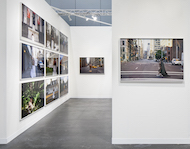New York, for all its bluster and glitz, is also a city of ghosts. It’s easy to ignore them—to get caught up in the swirl of what’s new—but every so often, on an empty cobblestoned street or in a darkened stairwell, you might feel their pull. They’ve been tugging at Brooklyn-born photographer Nona Faustine since she was a girl. She’d explore the city with her mother, running errands, wondering about who came before her. “I was always asking about the past, thinking about past New Yorkers,” she explains. But as she pursued an undergraduate degree at the School of Visual Arts, then a master of fine arts from the International Center of Photography (ICP)–Bard College program, she noticed that the city’s history as a slave trade capital was rarely mentioned, and that people who looked like her—“plus-size, dark skin”—were rarely depicted in museums or galleries. “I wanted to address that gap.”
So, 10 years ago, Faustine embarked on a project born more out of passion than anything else: a series of large-format self-portraits taken in front of the city’s less heralded spots—the sites of slave auctions, an African burial ground, the ports where slave ships once docked. In many of the images, she’s nude, save for a pair of white, high-heeled shoes. She appears vulnerable yet defiant, a stand-in for the forgotten. “It goes to a larger question about African American contributions,” she explains. “The unacknowledged voices; what’s been erased.”
Now that project, aptly titled White Shoes, will be presented at Higher Pictures Generation during New York’s Armory Show. Though the series has garnered considerable acclaim over the last decade—several of the original works are included in permanent museum collections, and an eponymous book was released last year—this is the first time that dozens of new, never-before-seen pieces will be shown, allowing viewers to fully absorb the force of Faustine’s seminal oeuvre. It’s a milestone she doesn’t take lightly, especially given the personal nature of the work. “It came from the purest, most from-the-soul expression, and that’s not always easy to share with the world,” she says. “It was my way of dealing with the sorrow and the horror and the complexity of our history here in America. To have people embrace it the way they have, it’s just incredible.”

